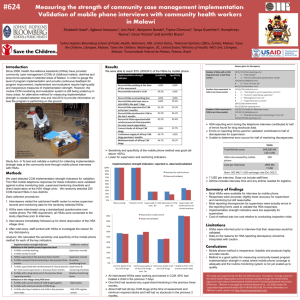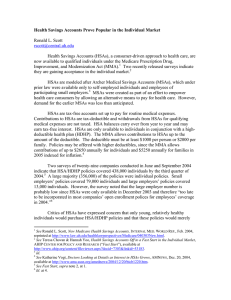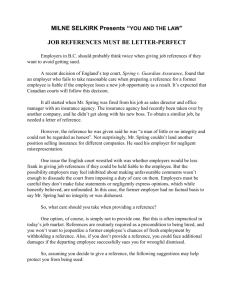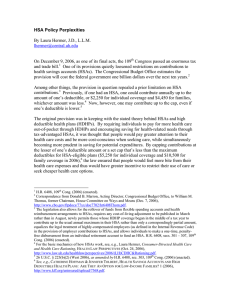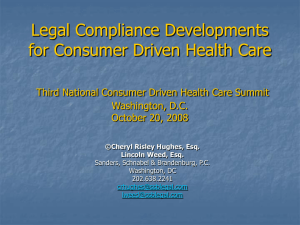Cato Institute - WordPress.com
advertisement
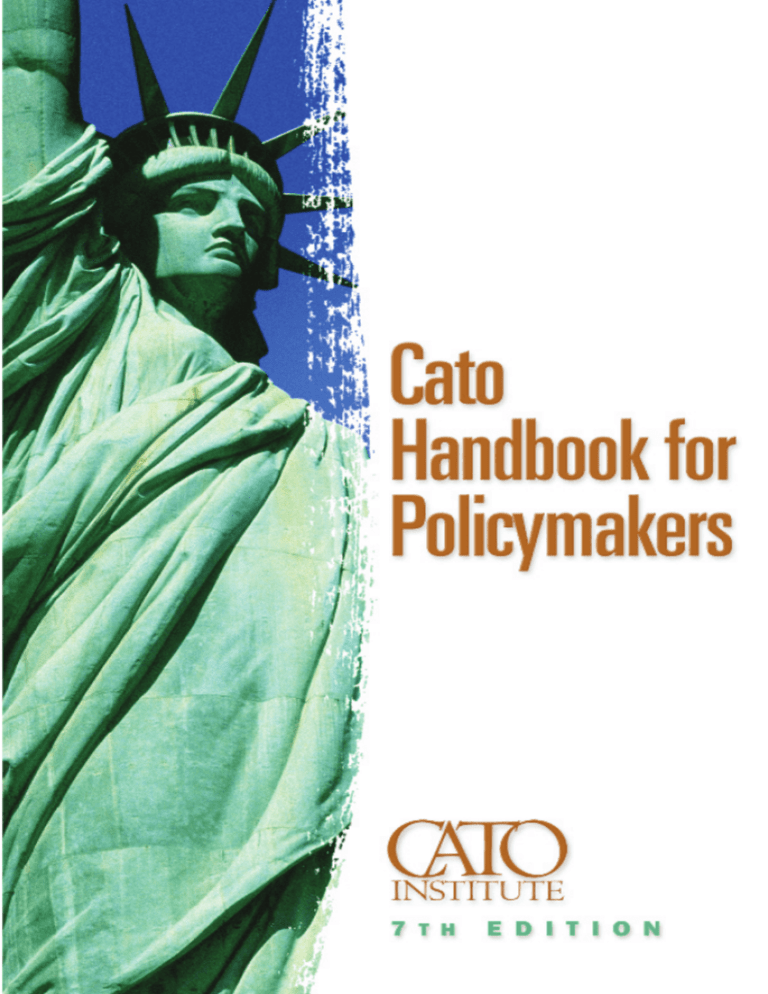
14. The Tax Treatment of Health Care State legislators should ● avoid creating special tax breaks for health insurance and medical care, and ● eliminate existing tax breaks for health insurance and medical care while reducing the overall tax burden. Congress should avoid refundable tax credits and other tax reforms that would create new categories of government spending; ● replace all existing health-related tax breaks with a tax break for ‘‘large’’ health savings accounts; and ● subsequently eliminate all tax breaks and reduce tax rates, by moving to a tax system that is neutral toward medical care and other forms of consumption. ● Many presume the U.S. health care sector to be a free market because the private sector plays a greater role in it than in other advanced countries. It is an error, however, to assume that a market is free because it is private. Government can exert as much control over the private sector as the public sector, simply by ordering private individuals and firms to apply their resources toward the government’s goals rather than their own. The fact that the U.S. health care sector is more ‘‘private’’ and less ‘‘public’’ than other nations’ therefore tells us little about whether that market is free or unfree. What matters—what determines real as opposed to nominal ownership—is who controls the nation’s medical resources. With Tax Cuts Like This, Who Needs Tax Increases? One of the most far-reaching and damaging ways that government controls private-sector health care is through tax laws. The federal govern141 CATO HANDBOOK FOR POLICYMAKERS ment exempts certain health-related uses of income from income and payroll taxes. The largest of these tax breaks is the exclusion of employersponsored health insurance from income and payroll taxes. Workers who obtain health insurance through an employer pay no taxes on the ‘‘employer contribution’’ to the premium, and (thanks to Section 125 plans) many workers pay no taxes on the ‘‘employee contribution’’ either. The tax exclusion for employer-sponsored health insurance is the largest tax break in the federal tax code. In 2007, the revenue loss to the federal government was $147 billion, nearly twice the size of the projected loss from the second-largest revenue loser, the mortgage-interest deduction. On an individual level, a worker’s health insurance premiums and marginal tax rate determine the value of the tax break. Both factors vary across workers. In 2007, the average family premium for job-based coverage was roughly $12,000, to which employers ‘‘contributed’’ an average of roughly $9,000. A worker’s overall marginal tax rate is determined by summing her marginal payroll tax rate for Social Security and Medicare (which can be as high as 15.3 percentage points), her marginal federal income tax rate (which may climb to 35 percentage points), and her marginal state income tax rate (which may climb as high as 10 percentage points). Workers who do not obtain health insurance in an employment setting face a concomitant tax penalty when purchasing coverage. They must purchase insurance with income that has already been taxed at marginal rates as high as 50 percent. As a result of the tax break for employersponsored insurance, consumers who seek to choose their own health insurance plan must often pay twice as much for less coverage. That hefty tax penalty discourages many workers from seeking insurance on the ‘‘individual’’ market. Even for workers with employer-sponsored health insurance, this tax break operates more like a tax increase. A survey by economists Michael Morrisey and John Cawley found that 91 percent of health economists agree that the money that employers use to purchase health insurance comes out of workers’ wages. In other words, if employers were not providing health benefits to workers, they would have to return that $9,000 to workers in the form of higher cash wages. That implies that, rather than encourage employers or shareholders to spend their own money on workers’ health benefits, this tax break instead gives employers control over a significant portion of their workers’ earnings. As a result, employers effectively control 28 percent of the $2.5 trillion sloshing around America’s 142 The Tax Treatment of Health Care health care sector. (See Figure 14.1.) Workers who wish to reclaim that money would probably have to find a different job that offers higher cash wages but no health benefits. (Employers seldom ‘‘cash out’’ workers who decline health benefits.) The workers would then have to pay taxes on that money, handing as much as $4,500 of it over to the government. If government took $9,000 from workers and used it to provide workers with health insurance, we would call that a tax increase. Yet when government drives a wedge between workers and $9,000 of their earnings, we rather curiously call it a tax ‘‘cut.’’ The tax exclusion for employer-sponsored health insurance has made a fine mess of private-sector health care. Even though workers pay for their job-based coverage through lower wages, that cost is not salient to Figure 14.1 America’s $2.5 Trillion Health Care Sector: Who Controls the Money? Consumers 26% Other Private 3% Employers 28% Government 43% SOURCE: Centers for Medicare & Medicaid Services. 143 CATO HANDBOOK FOR POLICYMAKERS them. Workers feel like they are spending someone else’s money. They therefore demand more health insurance than they would if they owned and controlled those dollars. The additional coverage they demand in turn insulates workers from the cost of medical care, which encourages workers to consume many low-value services. Duke University professor Christopher Conover estimates that the exclusion thus imposed a deadweight economic loss on U.S. consumers equal to $106 billion in 2002. It no doubt contributes to Dartmouth Medical School professor Elliot Fisher’s conclusion that as much as 30 percent of U.S. medical spending may do nothing to improve health. The exclusion affects workers negatively. Health insurance premiums persistently rise faster than wages, in part because the exclusion strips workers of any incentive to curb their medical consumption. Rapidly rising health insurance premiums eat into wage increases, but workers have little incentive or ability to do anything about it. When employers try to contain premiums with health plan features that discourage low-value care (such as cost sharing or managed care rules), workers revolt. And why wouldn’t they? Stanford economist Alain Enthoven estimates that ‘‘less than 5 percent of the insured workforce can both choose a health plan and reap the full savings from choosing economically.’’ The lack of choice hurts, too. Economists Mark Pauly, Allison Percy, and Bradley Herring estimate that reduced choice itself imposes on workers a welfare loss equal to somewhere between 5 and 10 percent of premiums. Tying health insurance to employment means that losing a job means losing health insurance. That leads to ‘‘job lock,’’ a phenomenon where workers would prefer to leave their jobs but feel compelled to stay lest they lose their health coverage. According to Mark Pauly and Robert Lieberthal, tying health insurance to employment also doubles the risk that many workers with high-cost medical conditions will end up uninsured. The exclusion also inhibits competition from potentially higher-value forms of health insurance and health care delivery. As Pauly and Lieberthal note, coverage purchased on the individual market doesn’t automatically disappear when a worker changes or loses a job—a feature that offers considerable security. Yet the tax exclusion penalizes that type of insurance. Enthoven argues that the exclusion holds back prepaid group practices like Kaiser Permanente, which have shown great promise in providing high-value care at a reasonable cost. Though many workers prefer such plans, others do not. Employers that offer just one insurance option therefore tend not to offer a prepaid group plan. At the same time, employers 144 The Tax Treatment of Health Care often avoid offering more than one plan due to the higher administrative costs. (See also Chapter 15, ‘‘Health Care Regulation.’’) Reforming of Health Care via the Tax Code Ideally, government would offer no special tax breaks for health care expenses. The purpose of taxes should be solely to raise revenue for the government. If the government must impose a tax, it should distort individuals’ economic decisions as little as possible. Creating special tax breaks for certain types of behavior—thereby imposing concomitant tax penalties on other behaviors—is just one more illegitimate tool for controlling the citizenry. If politicians want to subsidize an item like medical care, they should raise general taxes and spend the resulting revenue on that item. The ultimate goal of tax-based health care reforms should be to eliminate all tax breaks for health-related uses of income, and to tax medical consumption like any other type of consumption. Consumers should make choices about whether, where, and how much health insurance and medical care to purchase based on their values—not on the values that specialinterest groups have wormed into the tax code. Eliminating tax breaks is problematic both in principle and for political reasons. All else being equal, eliminating a tax break brings more revenue into government coffers. That increases government revenues and undoubtedly encourages mischief. In addition, to remove a tax break is to impose a tax on previously untaxed activity. Eliminating the tax break for employersponsored insurance would raise taxes on most U.S. workers by requiring them to pay payroll and income taxes on the value of their health insurance premiums. Workers are therefore likely to resist reforms that merely eliminate health-related tax breaks. A more sensible approach would eliminate those tax breaks and also reduce payroll and income tax rates to a point where the overall amount of revenue raised remains constant or even falls. That would prevent government budgets from growing. Yet even if government revenues remained constant, some individuals would pay lower taxes, while others would face higher tax burdens. The latter group—typically those with the most expensive employer-sponsored health benefits—would still resist reform. In the short term, therefore, it appears politically infeasible to eliminate health-related tax breaks completely. As a preliminary step, Congress should enact tax reforms that (1) reduce tax-based distortions within the health care sector and (2) prepare 145 CATO HANDBOOK FOR POLICYMAKERS consumers and the health care sector for a new tax system with no healthrelated tax breaks. Congress took a small step in that direction by creating tax-free health savings accounts (HSAs). HSAs are owned by the individual consumer and follow the account holder from job to job. A worker or her employer can make tax-free contributions to the worker’s HSA. If the worker uses those funds to purchase medical care, they remain untaxed. Interest earned on the account is likewise tax-free. HSAs enable workers to own and control a portion of their health care dollars, because HSA contributions receive the same tax status as employer-sponsored insurance premiums. Workers do not have to surrender those earnings to their employer to obtain the tax break. However, HSAs are only available to consumers who obtain a qualified highdeductible health plan that is rigidly defined by Congress. In addition, HSAs enable workers to control only a small portion of their earnings that their employer otherwise would control. The reason is that HSAs only create tax parity for HSA contributions. If workers want to purchase their own health insurance, generally they must still pay the premiums with aftertax dollars. HSAs offer small comfort to a worker whose employer doesn’t offer them, or who dislikes the one narrow type of health plan that Congress permits HSA holders to obtain. HSAs do, however, present an opportunity to reform the tax treatment of health care consistent with the two goals mentioned earlier. Congress should take three steps to expand HSAs: ● Increase HSA contribution limits dramatically, say, from $2,850 to $8,000 for individuals and from $5,500 to $16,000 for families; ● Remove the requirement that HSA holders be covered by a qualified high-deductible health plan, or any type of health plan; and ● Allow HSA holders to purchase health insurance, of any type and from any source, tax-free with HSA funds. Congress should replace all existing health-related tax breaks with one tax break for these new, ‘‘large’’ HSAs. Large HSAs would reduce distortions within the health care sector and allow workers to purchase the health plan of their choice. Moreover, they would give workers more immediate ownership over that $9,000 that their employer currently controls, and would engender less political opposition than other reforms. How would Large HSAs work? Suppose a worker currently receives family coverage through her employer. The total premium is $12,000 per 146 The Tax Treatment of Health Care year, of which the employer pays $9,000 and the worker pays $3,000. Rather than set aside $9,000 for the worker’s health benefits, the employer would add that amount to the worker’s salary. The worker would decide how much to contribute to her Large HSA. As with employer-paid health premiums today, those contributions would be exempt from both income and payroll taxes. She could then use those Large HSA funds to purchase health insurance, of any type, from her employer or another source, tax-free. She could stay on the company plan, or choose a policy that would stay with her family when she changes jobs. Her decisions about whether to purchase coverage, where to purchase coverage, what type of coverage to purchase, and whether to pay for medical care out-of-pocket or through insurance would be completely undistorted by the tax code. Unlike today, the worker would own every dime she spends on coverage and care, and therefore would seek out health plans and providers who deliver value for the money. Large HSAs versus Other Proposals Large HSAs have distinct advantages over other options for reforming the tax treatment of health care, including capping of the exclusion, tax credits (including refundable credits), a standard deduction for health insurance, and full deductibility for all medical spending. Any reform that achieves tax parity between employer-sponsored health insurance and other forms of insurance (e.g., tax credits, a standard deduction) will cause a certain amount of uncertainty and anxiety. Will healthy workers stay in their employer’s health plan? If they leave, will the premiums for the older, sicker workers who remain become unaffordable? Economists agree that if employer plans unravel, employers will return to their workers the money they were spending on health benefits. That will help any workers who are left in the lurch. However, there is also uncertainty about when employers will return those funds to workers. Large HSAs create a very visible moment when employers will be expected to add that $9,000 to workers’ cash wages—most likely, January 1 of the year that Large HSAs take effect. By ensuring that the shift occurs immediately, and by focusing attention on employers’ actions, Large HSAs would do more than other reforms to reduce uncertainty for workers, particularly high-risk workers. Thus, Large HSAs would reduce political opposition to parity in a way that other reforms cannot. Large HSAs would further mitigate political opposition because fewer workers would face tax increases than would occur under other reforms. 147 CATO HANDBOOK FOR POLICYMAKERS Had Congress enacted Large HSAs in 2006, fewer than 3 percent of workers with employment-based coverage would have seen any reduction in the amount of health benefits exempt from income and payroll taxes. And even those workers would have received a tax cut, because they would have gained ownership and control over the first $8,000 or $16,000 of their health benefits. Various estimates have shown that tax reform would reduce the number of Americans who lack health insurance. For example, the Congressional Budget Office projects that a standard tax deduction for health insurance would reduce the number of uninsured by nearly 7 million. Although no estimates have yet been made for Large HSAs, they likely would lead to a comparable reduction in the number of the uninsured. By comparison, other reforms leave much to be desired. Capping the exclusion has for decades been a political nonstarter, and would neither give workers ownership of their health care dollars nor achieve parity between job-based and other forms of insurance. Uniform tax credits would increase taxes on many workers, yet do nothing to encourage employers to cash out their workers quickly. ‘‘Refundable tax credit’’ is merely code for new government spending and would require even greater (i.e., less politically feasible) tax increases. Full deductibility for all medical spending, as advocated by economists John Cogan, Glenn Hubbard, and Daniel Kessler, would neither give workers ownership nor level the playing field, nor contain the economic distortions due to health-related tax breaks. A standard deduction for health insurance would dramatically reduce the tax code’s influence over consumer decisionmaking. Yet even that reform does little to alleviate the uncertainty about what will become of workers’ $9,000 when Congress levels the playing field between employment-based and other forms of insurance. Endgame Indeed, that uncertainty may be the most significant (if unacknowledged) obstacle to fundamental tax reform. If Congress attempts fundamental tax reform without first giving workers ownership of that $9,000, and giving consumers time to learn how to navigate health insurance markets, opponents will be able to demagogue tax reform to death. To succeed, the demagogues need only frighten a small share of the 180 million Americans with employment-based health insurance. Large HSAs, however, would allow tax reform to proceed in two steps. First, Large HSAs would give consumers control of the money that 148 The Tax Treatment of Health Care employers now spend on their behalf, and would acclimate consumers to making their own health insurance decisions. Consumers are likely to appreciate the option of purchasing health insurance that doesn’t disappear when they get sick and lose their jobs. Second, Congress could make the (much smaller) leap to a flat, fair, or national sales tax without having to answer consumers’ anxieties about whether they will be able to keep their health insurance, or whether employers will return to workers what’s rightly theirs. Suggested Readings Cannon, Michael F. ‘‘Health Savings Accounts: Do the Critics Have a Point?’’ Cato Institute Policy Analysis no. 569, May 30, 2006. . ‘‘Large Health Savings Accounts: A Step toward Tax Neutrality for Health Care.’’ Forum for Health Economics & Policy 11, no. 2 (2008). Cannon, Michael F., and Michael D. Tanner. Healthy Competition: What’s Holding Back Health Care and How to Free It. Washington: Cato Institute, 2007. Cochrane, John. ‘‘Time-Consistent Health Insurance.’’ Journal of Political Economy 103, no. 3 (1995). Hyman, David A. ‘‘Getting the Haves to Come Out Behind.’’ Journal of Law & Contemporary Problems 69, no. 4 (2006). Kling, Arnold. Crisis of Abundance: Rethinking How We Pay for Health Care. Washington: Cato Institute, 2006. Pauly, Mark V., and Robert D. Lieberthal. ‘‘How Risky Is Individual Health Insurance?’’ Health Affairs 27, no. 3 (2008). Pauly, Mark, Allison Percy, and Bradley Herring. ‘‘Individual versus Job-Based Insurance: Weighing the Pros and Cons.’’ Health Affairs 18, no. 6 (1999) —Prepared by Michael F. Cannon 149
